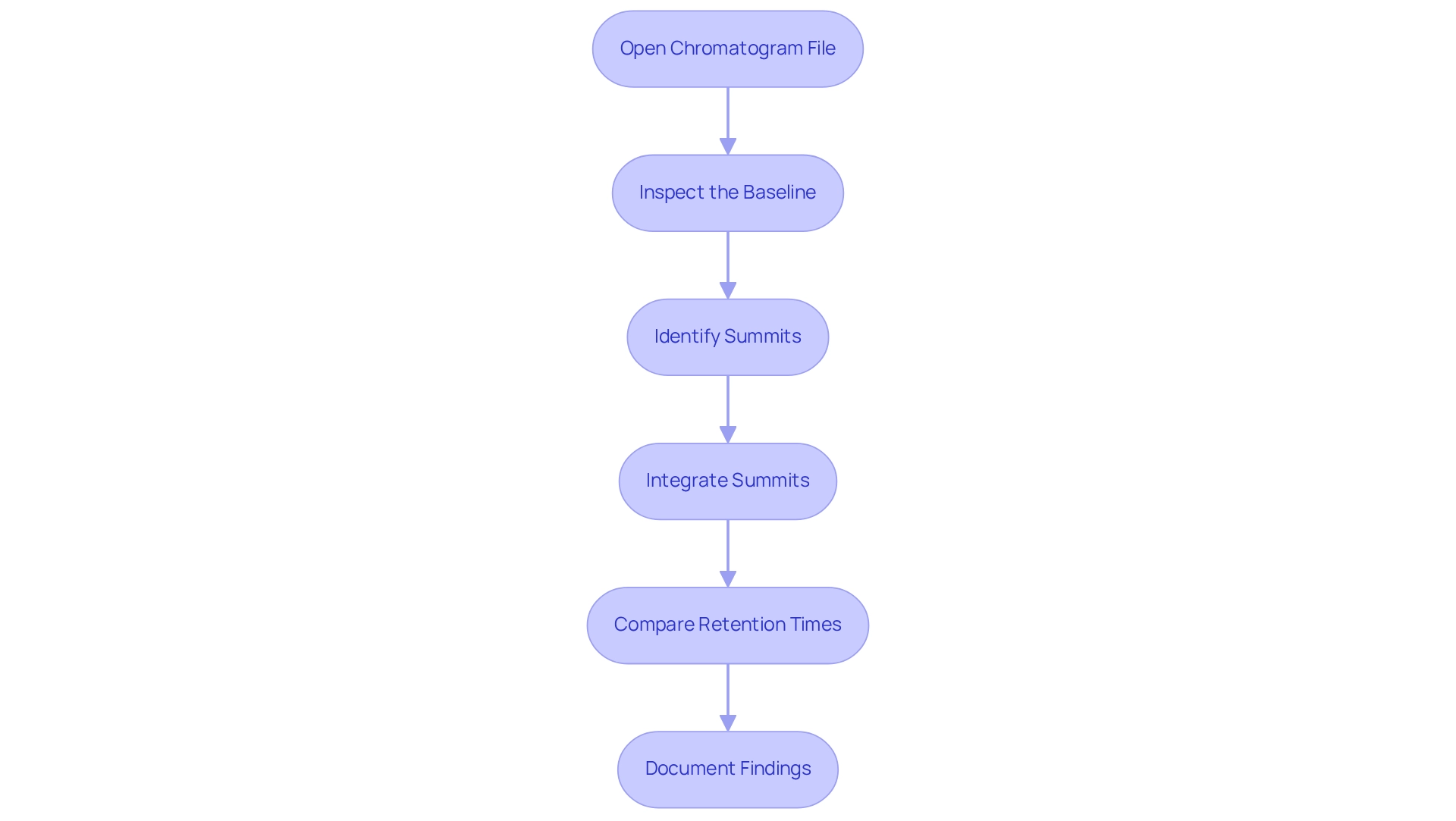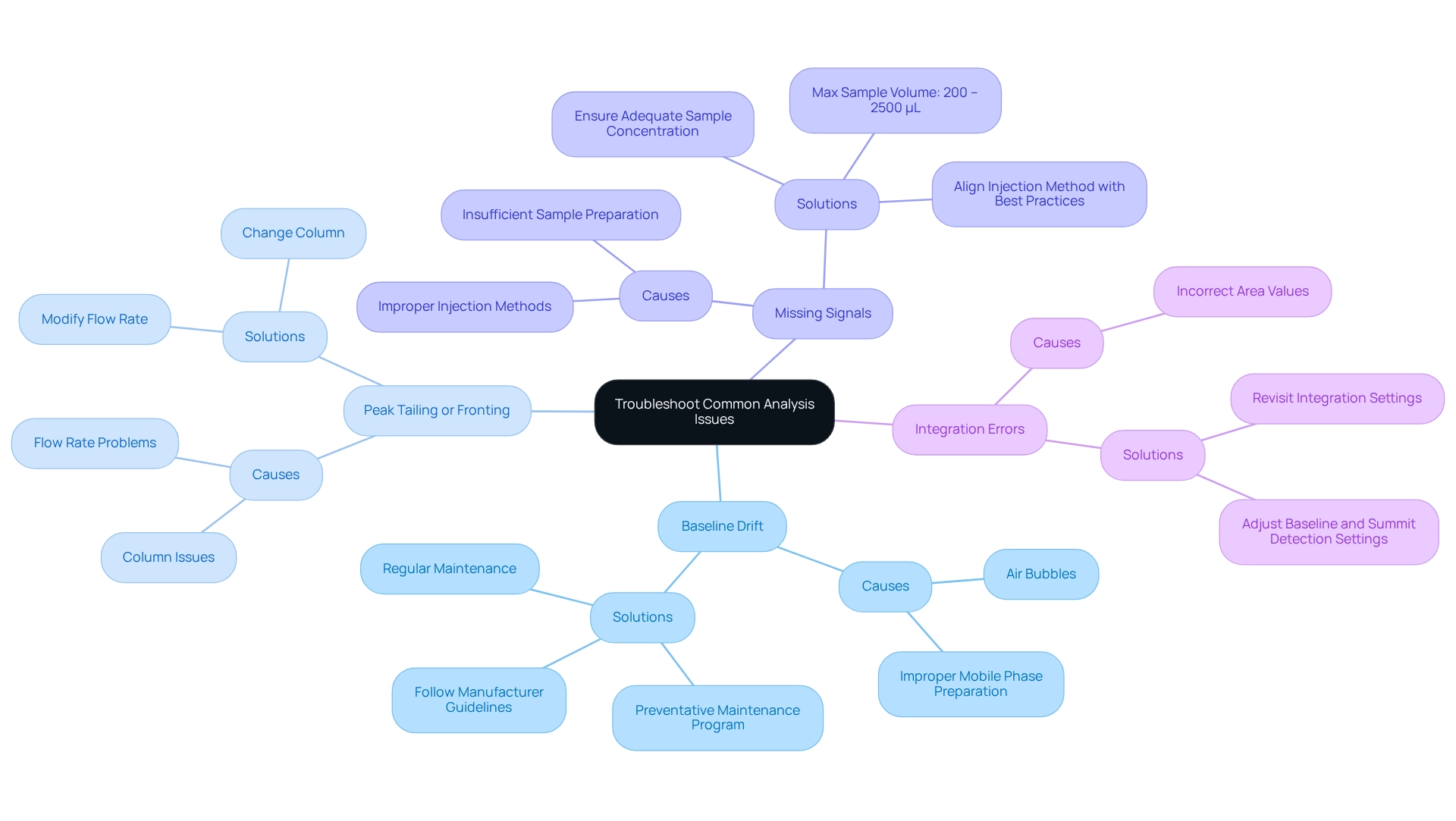Overview
Mastering chromatogram sequencing is crucial for achieving high standards in laboratory analysis. It requires a comprehensive understanding of the essential components of chromatograms, the right tools and software, and a systematic approach to data analysis. A solid grasp of chromatogram features can significantly enhance analytical accuracy and efficiency in laboratory settings.
By combining this knowledge with appropriate technology and effective troubleshooting strategies, professionals can elevate their analytical capabilities. Ultimately, investing in mastering these skills not only improves results but also fosters confidence in laboratory practices.
Introduction
In the realm of analytical chemistry, chromatograms serve as indispensable tools, offering a visual representation of the separation of components within complex mixtures. Understanding the intricacies of chromatogram analysis is crucial for laboratory professionals who seek to enhance their analytical capabilities. By exploring essential features of chromatograms—such as peaks, baselines, and retention times—practitioners can unlock valuable insights into sample composition. As technology continues to advance, the integration of sophisticated tools and software streamlines the analysis process, facilitating accurate interpretation of results. This article delves into the foundational concepts of chromatogram analysis, outlines the necessary tools for effective examination, presents step-by-step data analysis techniques, and discusses common troubleshooting strategies to ensure reliable outcomes across various scientific fields.
Understand Chromatogram Basics
A chromatogram serves as a vital graphical representation of the separation of components within a mixture, plotting time on the x-axis against detector response on the y-axis. Understanding its key features is essential for effective analysis.
- Peaks: Each peak signifies a distinct component in the sample, with the height and area of the peak directly correlating to the concentration of that component. Precise analysis of high points is essential, as they offer insight into the mixture's composition.
- Baseline: The baseline indicates the detector response level when no analytes are present. A stable baseline is crucial for accurate peak integration, ensuring that the information reflects true sample characteristics.
- Retention Time: This refers to the duration it takes for a component to traverse the chromatography system and reach the detector. Each compound exhibits a unique retention time under specific conditions, which is critical for identification and quantification.
Knowledge of these components not only enhances the examination of results but also assists in resolving potential issues. Recent advancements in chromatographic examination methods, including automated mass spectrometry processes, have further improved the precision and effectiveness of information interpretation across various fields, such as bioscience and environmental studies. For instance, a case study on retention time determination revealed that variations in peak shape could complicate interpretation, particularly in gas chromatography, underscoring the importance of grasping the fundamentals of chromatographic analysis. By mastering these foundational concepts, laboratory professionals can significantly elevate their analytical capabilities.
Gather Necessary Tools and Software
To perform an efficient chromatographic assessment with a focus on chromatogram sequencing, gathering the following tools and software is essential:
- Chromatography Software: Prominent applications like Chromas, FinchTV, and Geneious are well-known for their functions in displaying and examining chromatographic data. As we approach 2025, the emphasis is on software that enhances user experience and efficiency, so ensure you are utilizing the latest version available. The chromatography software market is projected to expand considerably from 2025 to 2030, driven by innovations that enhance analytical capabilities, particularly in chromatogram sequencing. Securing chromatographic files, typically in formats such as .ab1 or .scf, directly from your chromatography system will facilitate precise evaluation of chromatogram sequencing. Access to standard reference chromatographic profiles is crucial for comparison, enabling more accurate interpretation of your findings. Additionally, confirm that your computer meets the required specifications for the chromatography software to ensure seamless operation and prevent any interruptions during evaluation. By collecting these vital tools, you will optimize your evaluation process, greatly enhancing your capacity to interpret results related to chromatogram sequencing accurately. Recent trends indicate that the chromatography software market is set to grow, driven by advancements for enhanced efficiency and user experience, making it an opportune time to invest in the best tools available. Furthermore, the impact of macro factors, such as the COVID-19 pandemic, has underscored the significance of efficient examination of chromatographic outputs in laboratory practices. According to Oxford Economics, UK pharmaceutical output growth is projected to average 1.3% annually from 2024 to 2026, highlighting the need for reliable analytical tools. Additionally, data from related reports will be accessible in PDF, Word, and Excel formats for easy extraction and analysis.
Perform Step-by-Step Data Analysis
To analyze your chromatogram sequencing data effectively, follow these essential steps:
- Open the Chromatogram File: Begin by launching your chromatography software and loading the chromatogram file. This initial step is crucial for accessing your data.
- Inspect the Baseline: Examine the baseline for stability. A stable baseline is indicative of good data quality and reliability, which are vital for accurate analysis.
- Identify Summits: Leverage the software's summit detection feature to pinpoint all significant elevations. Adjust parameters as needed to ensure precise detection of these peaks.
- Integrate Summits: Quantify the components by integrating the area beneath each summit. Confirm that the integration settings align with your data characteristics for optimal results.
- Compare Retention Times: Align the retention times of your signals with those of recognized standards to accurately identify the components present in your sample.
- Document Findings: Record your results, including maximum heights, areas, and retention durations, for further examination or reporting, particularly focusing on chromatogram sequencing.
By adhering to these steps, you will be well-equipped to conduct a comprehensive examination of your chromatographic results. Recent advancements in peak integration techniques, such as the application of PETAL in biomedical research, have shown significant improvements in aligning and quantifying peptide features. This underscores the importance of precise information evaluation in advancing proteomic research. Additionally, with nearly 59% of companies employing over 10,000 employees utilizing artificial intelligence, the integration of AI in chromatographic data evaluation is increasingly significant. Staying informed about these developments will enhance your analytical capabilities and position you at the forefront of advancements in the field.

Troubleshoot Common Analysis Issues
Common issues encountered during chromatogram sequencing can significantly impact the accuracy and reliability of results. Understanding these prevalent challenges and their solutions is crucial for maintaining high standards in laboratory settings.
- Baseline Drift: An unstable baseline often results from air bubbles in the system or improper mobile phase preparation. Regular maintenance, including the replacement of pump seals, is essential to prevent such issues. Implementing a preventative maintenance program for new HPLC systems can also mitigate baseline drift. It is vital to adhere to manufacturer guidelines for column operational details to ensure optimal performance.
- Peak Tailing or Fronting: These phenomena frequently indicate problems with the column or flow rates. If shape distortions occur, consider changing the column or modifying the flow rate to enhance performance.
- Missing Signals: The absence of anticipated signals may arise from insufficient sample preparation or injection methods. Ensure that the sample concentration is adequate and that the injection method aligns with best practices. For a 250 x 25 mm column, the maximum sample volume should be between 200 – 2500 μL to ensure effective analysis.
- Integration Errors: Should the computed area values appear incorrect, revisit the integration settings in your chromatography software. Adjusting the baseline and summit detection settings can yield more precise outcomes. Addressing these frequent analysis challenges not only enhances the dependability of your findings but also aids in developing more efficient troubleshooting approaches by utilizing chromatogram sequencing. For instance, a case study on ghost peaks illustrated that employing sample cleanup techniques and ensuring solvent compatibility can significantly reduce the occurrence of these unwanted signals, leading to clearer chromatograms. As noted by Joe M. Davis from the Department of Chemistry and Biochemistry at Southern Illinois University, the initial hopes of researchers that SOT could be routinely used to estimate the number of components in mixtures remain largely unfulfilled, underscoring the importance of addressing these challenges. By staying informed about these issues and their solutions, laboratories can improve their analytical outcomes and uphold high standards in chromatographic practices.

Conclusion
Mastering chromatogram analysis is essential for laboratory professionals who seek to enhance their analytical skills. By comprehending the fundamental elements of chromatograms—such as peaks, baselines, and retention times—analysts can accurately interpret complex mixtures and unlock valuable insights into sample composition. The integration of advanced analytical tools and software streamlines the process, rendering it more efficient and reliable.
Equipping oneself with the appropriate tools, from specialized chromatography software to adequate reference materials, is critical for effective analysis. Following systematic steps to analyze chromatogram data ensures that practitioners can confidently identify components and quantify their concentrations. Moreover, being knowledgeable about common troubleshooting strategies enables prompt resolution of potential issues that may arise during analysis.
In conclusion, the ability to analyze chromatograms effectively transcends mere technical skill; it is a vital component of successful scientific inquiry across various fields. With ongoing advancements in technology and methodologies, remaining informed and adaptable will empower laboratory professionals to achieve accurate and reliable results. As the demand for precise analytical capabilities continues to grow, so does the importance of mastering chromatogram analysis in driving innovation and progress in scientific research.




